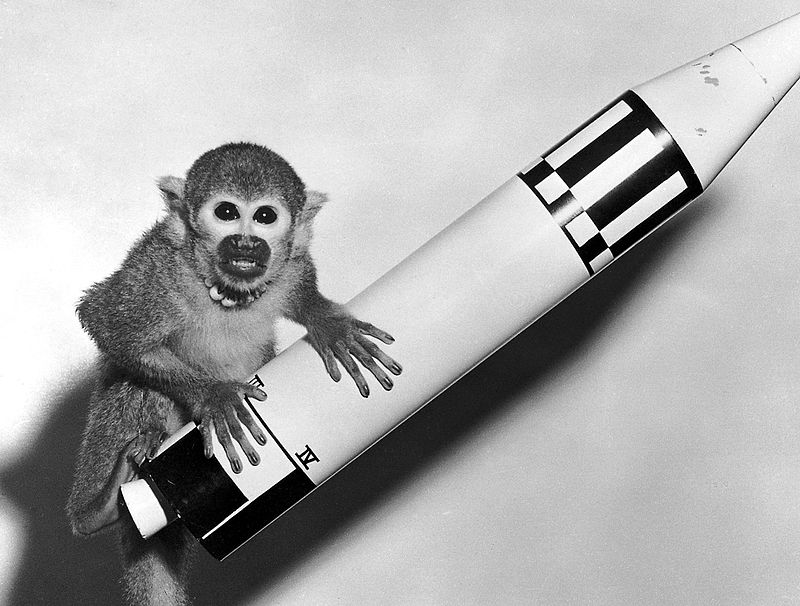On June 14, 1949, a drugged-up rhesus monkey named Albert II was buckled into a Nazi-designed missile at an airfield in White Sands, New Mexico. Called the Blossom V-2 rocket, the vehicle was a beefier version of the weapon Hitler had deployed only five years previously, in blitzes against Allied cities like London, Antwerp, and Liège.
But on that Tuesday 68 years ago, the rocket—swiftly adopted by the United States, along with its German developers—served a radically different purpose. After a successful lift-off, the Blossom V-2 propelled Albert II to an altitude of 83 miles (134 kilometers), making him the first primate ever to visit outer space, and thus paving the way for human spaceflight.
Videos by VICE
Sadly, Albert II paid for this milestone with his life. About three minutes after the launch, as the rocket reached its zenith, the monkey’s capsule separated from the booster for the trip back to Earth. Everything was proceeding smoothly until the parachutes were released, and failed to billow out to slow Albert II’s descent. About six minutes after he had been blasted from Earth, the six-pound monkey was killed upon his return, leaving 10-foot-wide crater to mark the impact.
His distress throughout this tumultuous ordeal is preserved in electrocardiographic data captured by sensors attached to his furry body. David Simons, the Air Force project officer for V-2 animal studies, reported that Albert II’s heart rate was “clearly disturbed” by disorienting g-force shifts, according to Animals in Space by Colin Burgess and Chris Dubbs.
“This is the first record made of an animal’s response to spaceflight,” Simons said in 2006, as quoted by Burgess and Dubbs. “I think it deserves recognition as such—several years ahead of the Russians.” (The Soviet space program’s first animal astronauts were Dezik and Tsygan, stray dogs who reached suborbital space in 1951.)
Read More: The Brave Bitches Who First Orbited Earth and Lived to Bark About It
As hinted by his regnal number, Albert II was not the first monkey to be martyred in early spaceflight experiments. Almost exactly a year before, on June 11, 1948, the original Albert, a nine-pound rhesus monkey, had been launched 39 miles above New Mexico on a Blossom V-2. The flight was short of the Kármán line (62 miles above Earth), which is considered the gateway to outer space, so it wasn’t considered a true spaceflight.
Sensors attached to Albert I suggest that he suffocated during the flight, or perhaps even during the launchpad countdown, before he even blasted off. Either way, he was dead before his capsule’s descent, and if he hadn’t been, he would have been killed when it crashed into the ground, since the parachutes didn’t work on this test run either.
Video explainer on Albert dynasty. Video: Vintage Space/YouTube
This ill-fated Albert dynasty of space monkeys continued with the launch of Albert III on September 16, 1949. He died when his V-2 exploded early in its ascent. Albert IV, like Albert II, surpassed the Kármán line and reached an altitude of 79 miles, becoming the second primate in outer space. Alas, also like Albert II, he was killed on impact when his parachutes malfunctioned. Yet another parachute failure doomed Albert V, who rode an Aerobee rocket in place of a V-2, in April 1951.
After these five fatalities, a monkey named Yorick—also known as Albert VI—initially survived an Aerobee rocket test, along with several mice, though he died two hours after touchdown, due to overheating and exposure while waiting for the recovery team. Even so, it was a moderately better result, and the name “Albert” was thereafter retired for space monkeys.

It wouldn’t be until 1959 that the United States would successfully return a primate—a squirrel monkey named Miss Baker—from space, and secure her post-flight survival over the long term. While Miss Baker’s partner, the rhesus monkey Able, died from electrode surgery complications days after their joint mission, she lived on until 1984, and is buried on the grounds at the US Space & Rocket Center in Huntsville, Alabama. Her fans, to this day, leave bananas on her tombstone.
As space historians like Amy Shira Teitel have noted, the early Albert monkeys are often forgotten “unsung heroes” of the American space program, overshadowed by the starpower of Miss Baker, or Mercury Program astro-chimpanzees Ham and Enos. But the early sacrifices made by these six pioneering Alberts formed the bedrock of crewed spaceflight in the United States, and gave their human relatives the boost they needed to leave primate footprints on the Moon.
Get six of our favorite Motherboard stories every day by signing up for our newsletter.
More
From VICE
-

Jeff Kravitz/FilmMagic, Inc -

(Photo by Savion Washington/FilmMagic) -

Good ol cousin Eddie aka Randy Quaid (Photo by Steve Schapiro/Corbis via Getty Images)

